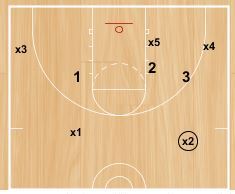
Submitted by Coach John Kimble
CoachJohnKimble.com
Retired high school and college coach
Follow him on Twitter @CoachJohnKimble
This post was originally written for Winning Hoops
INTRODUCTION
As in the majority of the drills, coaches should try to make the drills as “game-realistic,” as competitive, and as time-efficient as possible. Coaches should want to incorporate some offensive concepts and philosophies for one group of players to work on as another group within the drill works on developing specific defensive skills. This drill philosophy provides offensive as well as defensive teaching and practice during the same drill.
This drill can be a very effective breakdown drill for specific players to work on their particular transition responsibilities and assignments both defensively as well as offensively. This drill can be set up primarily for the two most important players in a team’s defensive transition—the two defenders that are to be first in getting back on defense. Every player should work on these two defensive positions because any player can end up in one of those particular positions. While not disregarding the other players in this drill, the two players that should be the first main focal points of the coaching staff’s attention are the initial two offensive players that will quickly become the two defenders that are in transition offense to defense. They are players X1 and X2 in the following diagrams.
The next focus is on the three offensive transition players that initially started on the defensive end. They are players O1, O2 and O3. During the next phase of the drill, the defensive focus is changed to the lone defender that goes back to the defensive end. This could be either O1, O2 or O3. During the same phase of the drill, the offensive focus is centered on X1 and X2 as they come down the floor in a 2-man offensive fastbreak.
If an offensive team shoots, misses, and surrenders a defensive rebound; there are two assigned positions for the first two defenders who are to get back on defense to protect their basket. If the offensive team loses possession of the ball via a turnover, there are no definite defensive transition assignments–it is simply imperative that the offensive team’s basket is immediately protected, regardless of who gets back first. That is the main reason that all players should be placed in these two positions with this drill.
THE INITIAL “3-ON-2” PORTION OF THE DRILL

The drill can be set up with two defensive players (X1 and X2) starting the drill by literally being seated near the offense’s sideline hash-mark, and three offensive players (O1, O2, and O3) in lines that start on the offense’s baseline. The ball is advanced via dribbling and/or passing with the three offensive players staying in their three wide lanes as quickly as possible to attack their basket. The two defenders must quickly scramble to their feet and then sprint back to defend their basket. (See Diagram 1)
Diagrams created with FastDraw

A more game-realistic method of starting the drill is to have the three offensive players (X3, X4, and X5) start in a “3 on 3” defensive alignment against three other players (O1, O2, and O3), with the potential two transition defenders (X1 and X2) making one or two passes before one of the other offensive players attempts to shoot and (intentionally) miss. The original three defenders (soon to become offensive players–O1, O2, and O3) work on boxing out, securing the rebound, and running a three-man fastbreak in the three lanes. The two original offensive players out in the front of the offense (X1 and X2) sprint back as quickly as possible, communicating loudly on whom is to become “Ball-Man” and whom is going to become “Basket-Man.” The dummy offensive players (X3, X4, & X5) step off the court and get ready to step into the roles that O1, O2, and O3 currently are playing. (See Diagram 2)
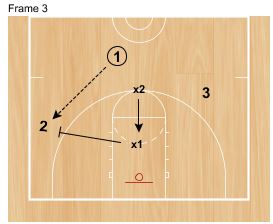
The first defender that gets back (X1 or X2; X1 in Diagram 2) settles in near the dotted circle in the middle of the lane and yells “Basket!” The second defender (X2 in the same diagram) that hustles back settles in the lane and cautiously approaches the dribbler as far out as the top of the key, by yelling “Ball !” The “Ball-Man” (X2) stops the dribble penetration of the dribbler, while the “Basket-Man” (X1) protects both low-post “blocks” and takes both the first and second perimeter passes made to either wing and then back to the center of the court. Therefore, when the offensive team passes the ball to either wing, the “Basket-Man” (X1) rotates out to defend the ball, while the original “Ball-Man” (X2) drops quickly down the lane to protect the basket. (See Diagram 3)
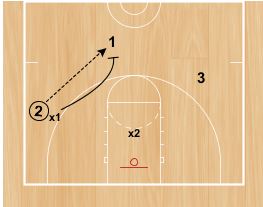
If the ball is passed from the wing back to the point, the original “Basket-Man”—X1 (who has defended the “Wing-Pass” — the first pass) would then defend the “Reversal Pass” also. This allows the original “Ball-Man”—X2, who has dropped down to protect the basket, to remain low to continue protecting both “blocks” and the basket. (See Diagram 4) To explain the rotation and the coverage in a simple manner, coaches should use the phrase, “The first ‘Ball-Man’ must stop the ball and the first ‘Basket-Man’ has the first two perimeter passes!”
Major Points of Emphasis for the Defense
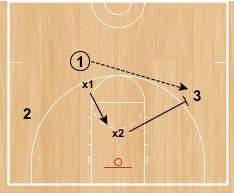
If the ball is centered up and then passed again from the top of the key to the wing on either side, the current “Basket-Man” (X2) would again come out to take the next two perimeter passes, with the current “Ball-Man” (X1) again dropping quickly to protect the basket. (See Diagram 5) The major points of emphasis for the two defensive players (X1 and X2 in Diagrams 2 thru 5) are:
- Make sure that there is absolutely no question or doubt whom has taken the “Ball-Man” responsibilities and that the other defender has taken the “Basket-Man” assignment. (Diagram 2)
- “Ball Defenders” (X2) must prevent dribble penetrations and drives to the basket and encourage the offense to pass the ball as often as possible–the more passes the opponents make, the more chance of a turnover and the more time the defense has bought to allow other defensive teammates to get back to help defend the basket. (Diagram 3)
- After the “Ball-Man” (X2 in Diagram 3) has stopped dribble penetration and influenced a pass to either wing, he must quickly drop to the weakside block area, as if he were defending a backdoor cut. That is, he would turn his back on the ball and face the weakside block area where O3 would most likely cut, looking down his extended right arm for the ball.
- The original “Basket-Man” (X1 in Diagram 3) should take the first and the second perimeter pass.
- Both defenders should remember that once the ball is centered back up, the new “Basket-Man” (X2 in Diagram 4) again has the “next two perimeter passes.”
The phrase used in teaching this part of the defensive transition is “Solidly build the defense starting from the basket and then build it out to the dribbler.”
Major Points of Emphasis for the Offense
The major points of emphasis for the three offensive players (O1, O2 and O3 in Diagrams 2 thru 5) are:
- The two wing players (O3 on the left and O2 on the right in Diagram 2 thru 5) should sprint out and get ahead of the ball, while constantly looking for the pass.
- When the cutting wings hit the free throw line extended, each should plant off of their outside foot, and slash-cut directly to the basket.
- The offensive team should try to keep the ball in the middle and get down the floor as quickly as possible, but under control.
- The dribbler (O1) should not anticipate that the defense will stop the dribble penetration and if not stopped, they should then attack the basket until someone does stop them.
- If and when the defense does stop the ball, that ball-handler should make a solid jump-stop and look to make a bounce-pass (below the outstretched arms of the defenders) to one of the cutting teammates.
- All offensive players should avoid offensive fouls as a result of out-of-control dribbling.
- If the ball is passed into a wing area to a player who is not driving (O2), that passer (O1) should then follow the pass a few steps to shorten the length of the potential return pass. (Diagram 4)
- All offensive players should remember to “take what the defense will give you” and not force the action.
THE “2-ON-1” PORTION OF THE DRILL
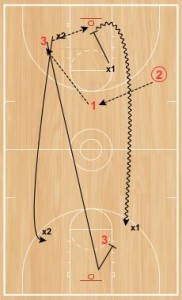
When the three offensive players (O1, O2, & O3) lose possession of the ball because of a made shot, a missed shot, or a turnover; either the shooter or the player who committed the turnover must turn and sprint back to protect the far basket by himself. The original two defenders (X1 & X2) would then sprint back and run a two-man offensive fastbreak against the new lone defender. (In this case, the lone defender is O3).
The new lone defender works on his defensive techniques as a solo defender against the two offensive opponents trying to score an easy basket against his transition defense.
Major Points of Emphasis for the Defense
The major points of emphasis for the lone defensive player (O3 in both Diagrams 6 and 7) are listed below. The lone defender should:
-
- Get back to protect his basket as quickly as possible.
- Not worry or sulk about the missed shot or the turnover.
- If possible, sprint into the lane and then turn around in the path of the dribbler with a wide and sideways stance, facing the receiver that is without the ball. In this manner, the defender has discouraged the dribbler from driving all the way to the basket. Being in this specific position-location, the defender has encouraged the dribbler into taking a jump shot or to pass the ball to the seemingly open teammate. Being in the sideways stance allows the defender to quickly rotate to the open man, when and if the pass is made. Coaches should use the phrase, “Physically you are here, but mentally you are there” to describe the “cat and mouse” game the lone defender must play with the two offensive opponents. (See Diagram 6)
- Slash at the new driver (if the pass is made to the open player—X2) at an angle so that he would go behind the driver and go for the block with his belly facing toward the back of the driver and his right hand going for the ball. This body position will allow the defender to avoid the light contact and foul. Coaching staffs should not encourage cheap-shots or dirty play; but they should tell their defenders that if they are going to foul, to foul in a clean manner so that the offensive opponent cannot get the shot off. They could use the phrase, “No cheap shots, but no touch fouls!”
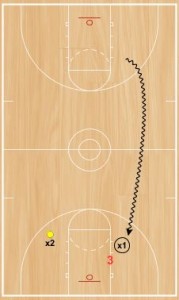
- Look to draw an offensive foul before a shot is taken. If the offensive charging foul is not called, a turnover might be caused or the worst case scenario might be that a blocking foul could be called. But that isn’t as bad as a two-shot shooting foul for the opponents
- Coaches should constantly remind the lone defender that he is at a numerical disadvantage, and that he is trying to “just buy his teammates some time.” The more passes and dribbling he can influence, the more time it would give his teammates to arrive back to help him “defend the gold—the basket.” Encourage the defender to be aggressive, but NOT to go out and attack the dribbler. This saying can be used frequently, “Remember that you have something that the bad guys want–our basket. You have something to protect, so stay at home and protect it.”
Major Points of Emphasis for the Offense
The major points of emphasis for the two offensive players (X1 and X2 in Diagrams 6 and 7) are:
- Both players should sprint quickly down the floor as quickly as possible, under control and looking for defenders as well as the basketball.
- Both should stay widely apart to prevent the one defender from being able to guard both of them,
- Offensive players should not make a decision too early on what they are going to do with the basketball-they should have an idea-but read the defense and take what the defense will give to them.
- Offensive players should remember that “rebounders jump while passers stay on the ground”—offensive players should not leave the ground to pass and get lured into an offensive foul, especially when there is an offensive numerical advantage.
- Offensive players should look to make bounce passes to teammates that are close to the basket, because those type of passes are more difficult for defenders to deflect or intercept.
After one shot or turnover, the “2-on-1” action is over. Then quickly begin to set up the next “3-on-2” scenario, and the drill continues without any interruptions. (See Diagram 7)
This drill works on specific techniques for the defensive transition as well as the offensive transition. Offensive fundamentals such as passing, catching, dribbling, running, shooting, and quickly getting back on defense are incorporated in this drill on a fast paced full-court scale. Defensive fundamentals such as stopping dribble penetration, guarding the ball, reacting to passes, defensive box-outs, defensive rebounding, and quick and immediate full court offensive transition. For both groups, there is a certain level of physical conditioning in running full court sprints.
SUMMARY
This drill is a unique way to break down techniques and concepts to both teach and review to all players concerning offensive and defensive basketball. Defensively, a coach must be able to teach and coach his players to prevent the opposing teams from getting any easy points. They must instill the philosophy “That if a team is going to score on us, they must have to work to earn those points!” Conversely, successful offensive teams are teams that know how and are able to score a few easy points in each and every game to counter the tough defenses that they will eventually face somewhere in their season.
The drill allows for players to be able to run and jump and cut loose with a lot of energy. It can be a helpful conditioning drill, but also a motivational and inspirational way to start off a practice with all of the movement and structured freedom that can be incorporated into the drill.
And as in all of the drills, it combines both offensive and defensive fundamentals and basics into the same fluid and time-efficient drill; making it an invaluable teaching and evaluating tool for coaches.
About the Author
Coach Kimble was the Head Basketball Coaching position at Deland-Weldon (IL) High School for five years (91-43) that included 2 Regional Championships, 2 Regional Runner-Ups and 1 Sectional Tournament Runner-up. He then moved to Dunlap (IL) High School (90-45) with 2 Regional Runners-up, 1 Regional, 1 Sectional and 1 Super-Sectional Championship and a final 2nd Place Finish in the Illinois Class A State Tournament. He was an Assistant Basketball Coach at Central Florida Community College in Ocala, FL for 1 year before becoming Offensive Coordinator and then Associate Head Coach for 3 additional years He then was the Head Basketball Coach at Crestview (FL) High School for 10 years, averaging over 16 wins per season.
He has had articles published in the following publications such as: The Basketball Bulletin of the National Association of Basketball Coaches, the Scholastic Coach and Athletic Journal, Winning Hoops, Basketball Sense, and American Basketball Quarterly. He has also written and has had five books published along with over 25 different DVDs by Coaches Choice and Fever River Sports Production.
See him on Twitter @CoachJohnKimble and his Web Page “www.CoachJohnKimble.com”






